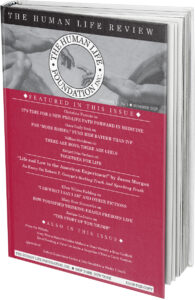Sew What
Fifteen years ago, someone in the United States would wear a garment seven to ten times before getting rid of it Now it’s worn only two or three times. Roughly 11.3 million tons of discarded clothing winds up in U.S. landfills annually; about 60 percent of it made of synthetic materials such as polyester, nylon, and acrylic, the mainstays of modern-day “fast fashion.” Synthetic fibers do not biodegrade easily and can stay in landfills for hundreds of years. Microplastics—minuscule bits of plastic between 1 micron and 5 millimeters in size—are used to make these synthetic fibers. They pollute oceans, soil, drinking water, and food, and have been linked to infertility problems and other health issues.
So-called fashion influencers on social media are a driving force behind the whopping increase in clothing consumption and its subsequent disposal. Since their content is devoted to the latest fashions, they must constantly present their followers with new “looks.” Prior to the 1950s there were two fashion seasons: Spring/Summer and Fall/Winter. Fast fashion companies have invented a mindboggling fifty-two “micro-seasons,” so now you will be considered “out of trend” after only one week.
Because of our “throwaway” culture, influencers can easily get followers to jump on their super-consumer bandwagon. And, really, it’s nothing new. The August 1955 issue of Life magazine ran an article titled “Throwaway Living,” which has been cited as the first to use the term “throw-away society.” Back then, this was considered a positive thing. It was believed that “disposable” made life easier as well as economical for the homemaker. Americans started viewing being thrifty as “un-American.” Go figure. In any case, here we are. What to do? Get retailers to give up a lucrative market? Dream on. Hope, as manufacturers of sturdy garments do, that Americans will return to the practice of taking good care of one’s wardrobe and repairing when possible? Maybe . . . right after they take up churning butter. So, again, what to do? Well . . .
If the mountain will not come to Muhammad, then Muhammad must go to the mountain.
Let’s wear money. Not actual money, not stitching dollar bills together, or if you’re Elon Musk, Benjamins, but what money is made from, which is not paper but rags. Called rag sheet, it’s produced by turning cotton and linen fabric into a 25 percent linen and 75 percent cotton “paper” pulp. This is why dollars left in a pants pocket that goes through the washing machine don’t dissolve. Unlike synthetic material, clothing made from the same stuff as money would be biodegradable. U.S. currency lasts for about six years before being taken out of circulation, easily outpacing a fast fashion “micro-season.” So- called distressed jeans are made to look worn-out even though they are actually new. So, not only would clothing made from “money” fit the bill, pun intended, but it might give a whole new meaning to saying someone looks like Old Money. That’s a joke.
What’s not a joke is our culture’s nonchalant attitude about being a throwaway society. Nor is the sartorial power of influencers. An influencer is someone who creates an engaging online presence using appealing content, such as provocative photos and videos. Although not celebrities in the traditional sense, they grow their online platforms through social media and then use their popularity to influence people’s buying habits. Some vendors feel this is even more effective than movie star glamour because it uses direct audience interaction to establish appeal. Whereas a celebrity won’t message you back online, influencers are approachable and so are more trusted; resulting in the ridiculous notion of 52 “micro-seasons” not being laughed right off the internet, thank you very much!
And then there are the unethical labor practices in under-regulated factories overseas that allow fast fashion to produce clothing so cheaply. In 2013 a deadly garment industry accident occurred in Bangladesh when structural building codes were not enforced and the Rana Plaza Factory collapsed. Eleven hundred people were killed, 2,500 more injured. In response, the Bangladesh Fire & Safety Accord was signed on May15, 2013. Most North American retailers did not sign the accord because of liability worries, but on July 10, 2013, a group of major U.S. retailers, naming themselves the Alliance for Bangladesh Worker Safety, announced the Bangladesh Worker Safety Initiative. It drew criticism from labor groups, who protested that it was less rigorous than the Accord and lacked legally binding assurances to pay for upgrades. Apparently the 1911 Triangle Shirtwaist Factory fire in New York City, which killed 146 workers, most of them young women and girls, was not top of mind.
In an International Law and Policy Brief, author Emma Ross writes: “Consumer demand for a larger quantity of clothing at a cheaper price point has pushed development of the fast fashion industry. This has led to the dangerous exploitation of the labor force who makes the fashion industry possible . . . In order to prevent further damage to garment workers it is necessary that legislation emulating the Bangladesh Fire & Safety Accord be put into place in every country. It is imperative to address and resolve the human rights violations occurring as a result of fast fashion.”
Isn’t our “throwaway” society in all its forms predicated on the perception of unlimited abundance at the expense of others? Throwaway Fashion: It’s so cheap I can just buy more. Throwaway Marriage: There’s Plenty of Fish in the Sea. Throwaway Pregnancy: I can always have another. Isn’t it all cut from the same cloth?











I couldn’t agree more.
Great article, thank you.
I’ll note I just took off a tie I remember buying sometime around 1992.